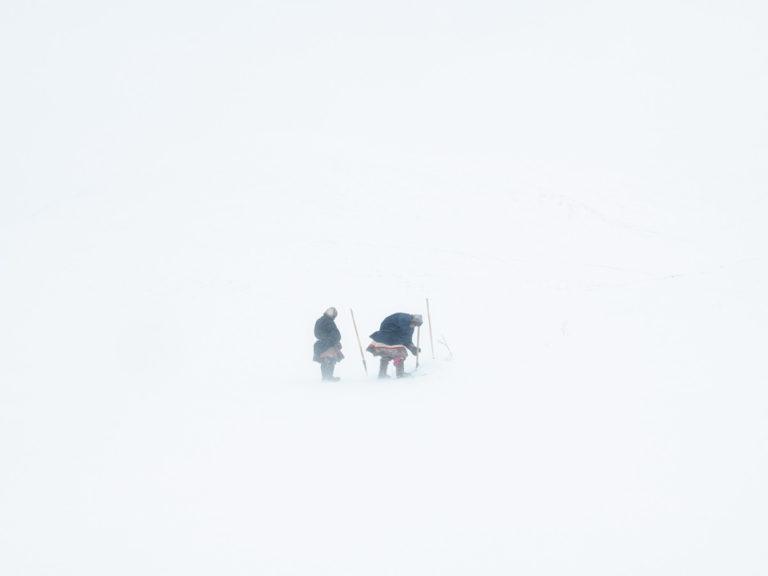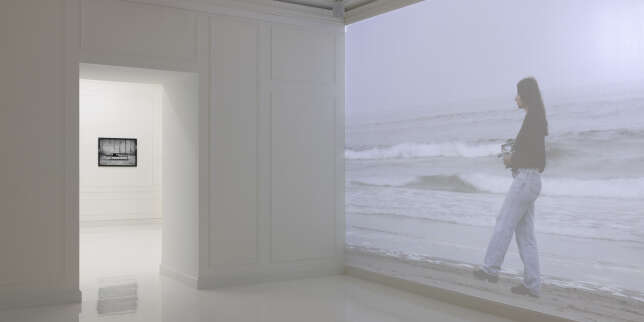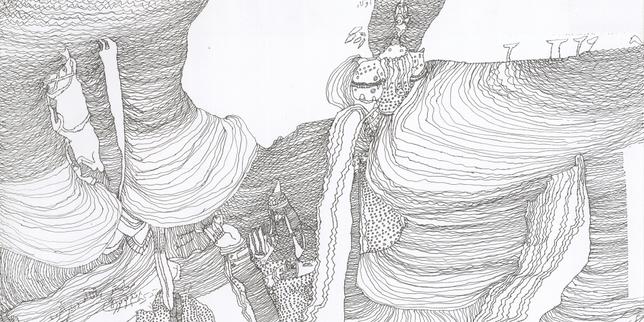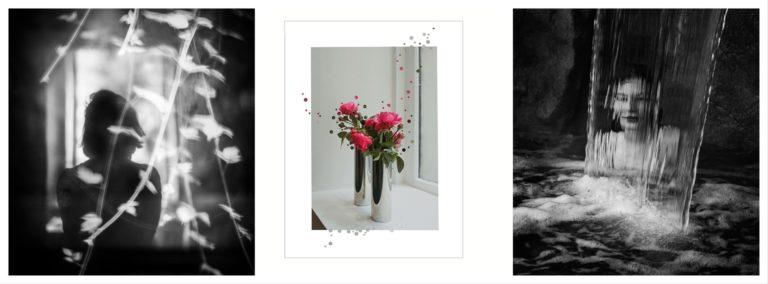Escenarios (Sceneries)
2014 - Film & Video (Film & Video)
15:00 minutes (looped)
Maya Watanabe
In Escenarios (Sceneries) Maya Watanabe films forgotten wastelands through a series of 360° camera movements that highlight the dramatism and visual richness of terrain that would be otherwise forgotten. Her choice to depict these lands is a reference to the devastated geography that now grips her Peru after decades of destruction from a grueling Civil War—the second largest internal conflict in the history of Latin America. Through the videos of this post-conflict territory she alludes at once to the sombre episode in Peru’s recent history, as well as her memory of it: fragmented and contused. Escenarios is a three-channel video installation with each screen showing barren, isolated or forbidden locations, all relating to the tumultuous history and present status of Peru. One screen records “El Frontón”, an island located off the coast of Lima that used to be the location of a prison. In 1986, in response to an uprising, the Peruvian Navy bombed the site, killing 80% of the prisoners. The subsequent court case is still pending, and today it’s forbidden to access the island, which seabirds have now colonized. The second screen’s subject is a landfill. In the desert, mounds of rubble and trash look like derelict, forgotten cities. The refuse smolders and a beat-up car burns. The final screen documents a large open-air cemetery. Crosses and shrines emerge from the thick fog and vultures swoop overhead ominously. In Escenarios memory is a difficult entity. It is recorded in the land that constitutes the country. In the video, Watanabe deals with the armed conflicts in Peru between the 1980s and 2000s in an abstract and open way. The video loops in an endless long-take that suggests memory is a mute and unresolved issue.
Drawing on her background in theater design and direction, Maya Watanabe is known for her multi-channel video installations that explore the relationship between language, collectivity, identity, and space. Considering words, silences and the interweaving of the two, her videos are often slow, controlled, and cyclical in nature. Earlier works incorporate references and methodologies from cinematographic language, often involving one or several actors performing a script and interacting with the camera through choreographed movements. The texts narrated by the actors are either borrowed quotes from movies or modified poems and scripts, which become untethered when taken out of their original context. The ambiguity and lack of narrative that results reveals the imprecise nature of perception and the images and memories that we rely to construct identity. Recent works examine the landscape, exploring their tendency towards the fantastical and ability to conjure memories. With particular attention to the legacy and history of Peru, her work considers the fragmented, uprooted, and mutable past of a place, and how issues of historical instability can take centuries to resolve.
Colors:
Related works sharing similar palette

© » KADIST
Mateo Lopez
2012With Roca Carbon ( Charcoal Rock , 2012) and Roca Grafito ( Graphite Rock , 2012), López plays with our relationship to inert and unremarkable objects such as rocks...

© » KADIST
Gabriel Pericas
2014“Efficiency & Abyss 1” is part of a series of photographs of stacked chairs in an auditorium...

© » KADIST
Luke Butler
2008In Captain X , Star Trek’s Captain Kirk, played by William Shatner, is limply draped over a large boulder in what looks like a hostile alien environment...

© » ARTS EQUATOR
How the Singapore literary ecosystem tackles mental health | ArtsEquator Thinking and Talking about Arts and Culture in Southeast Asia ArtsEquator Viewpoints December 27, 2021 By Sarah Tang (1,450 words, 5-minute read) cw: Contains mentions of suicide There appears to be more local books and writing about mental health in the Singapore lit scene in recent years...

© » KADIST
Randa Maddah
2017Shot from the rooftop of her house in Majdal Shams, through a complex construction of moving mirrors, this video connects both sides of the border which has cut through Syrian Golan heights since the 1967 Six-Day war...

© » ARTS EQUATOR
SDEA Theatre Arts Conference Keynote Interviews: Drama lessons in a pandemic (Part 2) | ArtsEquator Thinking and Talking about Arts and Culture in Southeast Asia ArtsEquator Viewpoints May 17, 2021 By Sarah Tang SDEA is holding its first fully online Theatre Arts Conference this year, since its inaugural run in 2011...

© » KADIST
Daniel Keller
2013To make the video installation Soft Staycation (Gaze Track Edit) , the artist, playing the role of ‘job creator’, hired a group of unemployed and expat freelancers through Craigslist to watch a 30 minute compilation of national tourism ads...

© » KADIST
Melvin Moti
2015Cluster Illusion examines the brain’s tendency to recognize a pattern as something abstract...

© » KADIST
Nikita Kadan
2013Ukraine is under tension due to the politics of President lanoukovitch since 2010...

© » EYE OF PHOTOGRAPHY
© 2023 All rights reserved - The Eye of Photography Jour de pêche - Russie 2019 © Corinne Vachon Ali Khan - Afghanistan 2019 © Corinne Vachon Rosan Gela - Pérou 2022 © Corinne Vachon Shambi Balas - Afghanistan 2019 © Corinne Vachon Jeunes Nénètses - Russie 2018 © Corinne Vachon On the occasion of PhotoSaintGermain and PARIS PHOTO, DartBLAY a gallery in Paris since 2011, presents SI LOIN, SI PROCHE, an exhibition displaying the photographic diary of Corinne Vachon, around the world...

© » TATE EXHIBITIONS
Future Forecast | Tate Liverpool + RIBA North See an audio-visual work created by the Greenhouse Project Young Event Producers Produced by a group of young people from Toxteth called the Greenhouse Project Young Event Producers, this 24-minute film is an imagined vision of the future, where extreme weather conditions have changed the landscape of Liverpool, and the rest of the world...

© » KADIST
Mateo Lopez
2012With Roca Carbón (Charcoal Rock, 2012) and Roca Grafito ( Graphite Rock , 2012), López plays with our relationship to inert and unremarkable objects such as rocks...

© » KADIST
Luisa Lambri
2007Rudolph Schindler’s designs, part of a practice he called “Space Architecture,” marry interior with exterior and space with light...

© » LE MONDE
Sarah Brahim remonte ses souvenirs dans un maelström de gestes et de sons Cet article vous est offert Pour lire gratuitement cet article réservé aux abonnés, connectez-vous Se connecter Vous n'êtes pas inscrit sur Le Monde ? Inscrivez-vous gratuitement Article réservé aux abonnés Vue d’ensemble de « Sometimes We Are Eternal », exposition de Sarah Brahim, à Lugano (Suisse), en octobre 2023...

© » KADIST
Teppei Kaneuji
2014In his White Discharge series (2002 to today), arguably his best known works, Kaneuji assembles old toys and plastic scarps into dramatic mounded heaps and covers the surface with white plastic resin, drawing on allusions to landfills, commodity fetishism, and creative repurposing...

© » LE MONDE
Sélection galerie : Farnood Esbati chez Christian Berst Cet article vous est offert Pour lire gratuitement cet article réservé aux abonnés, connectez-vous Se connecter Vous n'êtes pas inscrit sur Le Monde ? Inscrivez-vous gratuitement Article réservé aux abonnés Sans titre (vers 2020), de Farnood Esbati...

© » KADIST
In this interview, artist Pio Abad discusses his solo exhibition Kiss the Hand You Cannot Bite that draws from multiple histories of exile, resistance, and displacement from the ’70s and ’80s that brought Filipinos to California, home today to one of the largest diasporas of this community in the world...



